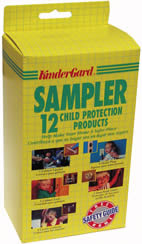No matter if your current relationship to a child is as a parent, a child-care provider, a babysitter, a relative or friend; possessing some handy skills such as First-Aid and CPR Training (usually available at your local American Red Cross) are invaluable.
In addition, here are some affordable, comforting products to help keep children safe no matter the situation:
This Sampler kit contains the necessary child protection basics for the home:
2 Cabinet Latches, 4 Outlet Plugs, Cabinet Lock, Door Knob Guard, 4 Corner Cushions
This guard is worn by the child and the cartoon animal-shaped transmitter sends a constant signal to the receiver, which is held by the adult. The signal is adjustable - from a distance of 6 to 30 feet, so when the child goes beyond the set distance, the adult receiver starts to beep, letting them know that the child is starting to wander off.
In honor of Earth Day last week, here are some helpful tips on teaching children the value of learning 'green' habits. Such as turning off lights and turning off water while brushing.
http://childparenting.about.com/od/socialdevelopment/tp/growupgreen.htm





